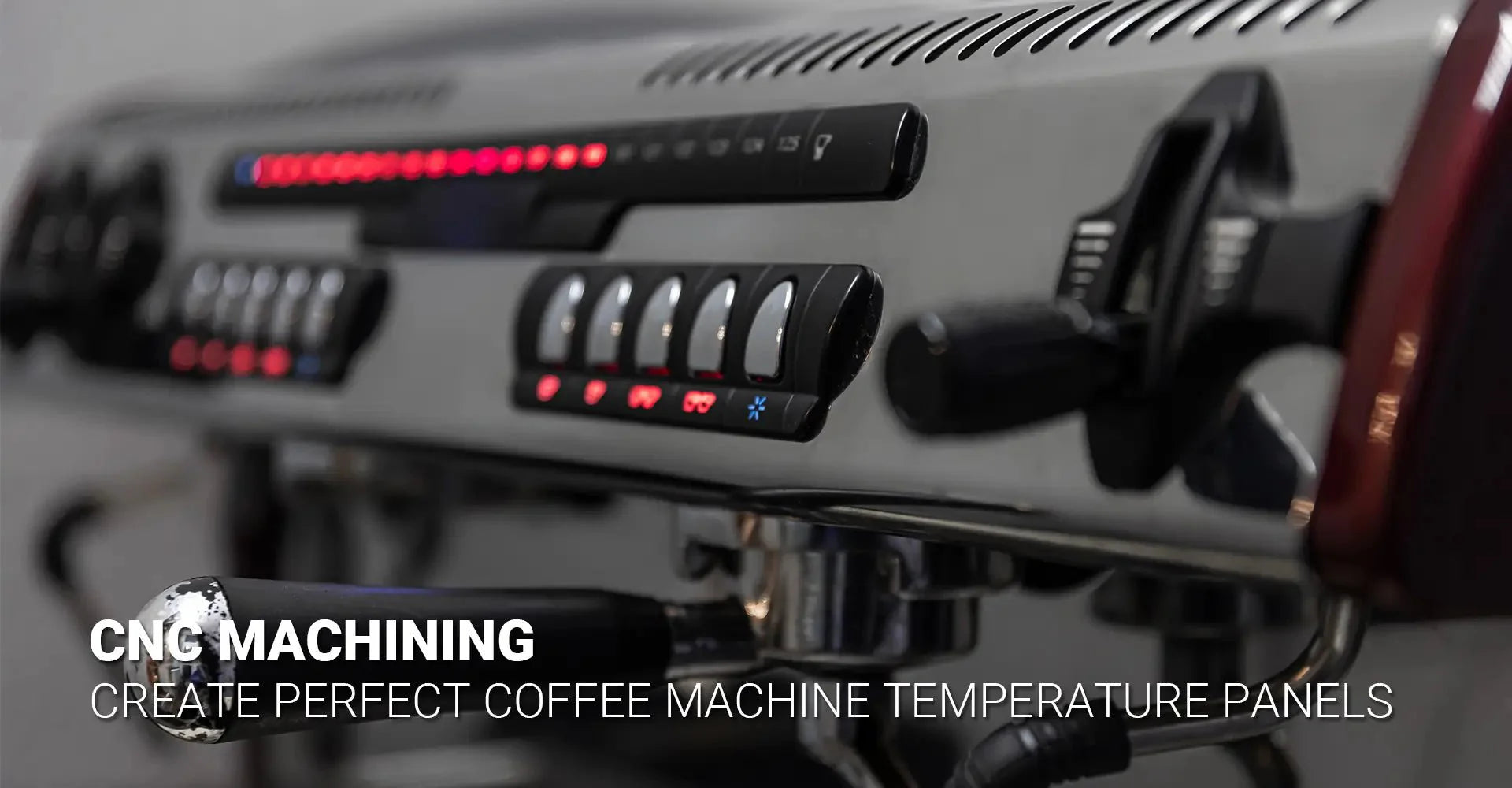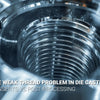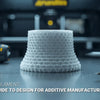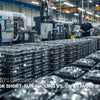How Does CNC Machining Create Perfect Coffee Machine Temperature Panels?

How Does CNC Machining Create Perfect Coffee Machine Temperature Panels?

The precision of your morning coffee depends heavily on temperature stability—a factor controlled by carefully machined thermal panels. These critical components require meticulous manufacturing processes to maintain the exact 195-205°F (90.5-96.1°C) brewing temperature that coffee experts demand. The journey from raw aluminum to a functioning thermal interface involves specialized CNC machining workflows that balance precision, thermal conductivity, and durability.
CNC machining for coffee machine temperature panels follows a detailed 14-step process from initial CAD design to final calibration, typically requiring 23 hours of machining and 8 hours of post-processing. With proper tooling and material selection, manufacturers can achieve the ±0.5°C temperature stability required for specialty coffee certification while maintaining production efficiency.
This article explores the comprehensive CNC machining workflow specifically designed for coffee machine temperature panels. We'll examine each critical manufacturing stage, material considerations, quality control parameters, and how these technical specifications directly impact your coffee's taste and consistency.
[Table of Contents]
- From CAD to Calibration: What Does the 14-Step CNC Journey Involve?
- Why Do Micron-Level Tolerance Errors Impact Coffee Taste?
- How Does Surface Treatment Affect Thermal Performance?
- What Material Selection Criteria Matter Most for Temperature Stability?
- Conclusion
From CAD to Calibration: What Does the 14-Step CNC Journey Involve?
The manufacturing journey begins with detailed 3D models that specify not just dimensions but thermal properties. Engineers must account for heat transfer rates, thermal expansion coefficients, and optimal contact points between the panel and brewing components. A successful CAD model includes tolerance specifications as precise as ±0.01mm to ensure proper thermal conductivity across the entire surface.
The CNC machining workflow typically starts with material selection (usually 6061-T6 aluminum for its excellent thermal conductivity of 167 W/m·K), followed by toolpath generation, where AI-based nesting algorithms have reduced material waste by 65%. Machine setup incorporates thermal compensation factors to account for the 23.6μm/m·°C expansion rate of aluminum during high-speed machining operations.
During the machining phase, tool selection becomes critical—carbide end mills with specialized geometries maintain ±0.02mm tolerances even after hours of continuous operation. Surface finish requirements, typically specified at Ra 0.4μm or better, ensure maximum thermal contact efficiency. Post-machining processes include precision deburring, surface treatment evaluation, and first-article inspection using coordinate measuring machines (CMM) with 0.003mm resolution capabilities. Each of these steps contributes to the final panel's ability to maintain consistent heat distribution across the brewing system.
Why Do Micron-Level Tolerance Errors Impact Coffee Taste?
Even minor deviations in panel flatness can significantly impact temperature consistency during brewing. Case studies have shown that flatness errors of just ±0.05mm can cause temperature drifts of 2.3°C—far exceeding the ±0.5°C variance allowed by Specialty Coffee Association of America (SCAA) standards for professional machines.
Temperature inconsistencies directly affect extraction rates of various coffee compounds. Errors in PID controller performance due to poor thermal panel machining can cost manufacturers up to $8,000 per production run in warranty claims and rework. A 3-stage CMM inspection protocol has proven effective at catching these issues before assembly, reducing defect rates from 4.2% to 0.3%.
Thermal interface panels function as critical heat transfer components between heating elements and water pathways. When thermal conductivity is compromised by machining flaws, brewing temperatures fluctuate during extraction, altering the release of acids, oils, and aromatic compounds. According to laboratory testing, a 1°C temperature deviation changes extraction yield by approximately 0.8%—enough to noticeably impact flavor profiles. Quality control managers now implement go/no-go gauging systems calibrated to detect surface irregularities smaller than 0.01mm, preventing these costly quality issues.
How Does Surface Treatment Affect Thermal Performance?
The final surface treatment of CNC-machined temperature panels creates a technical dilemma for manufacturers: balancing thermal conductivity with durability and aesthetics. Each finishing method significantly impacts heat transfer rates between components, with some popular treatments reducing thermal efficiency by nearly 20%.
Type III hardcoat anodizing increases scratch resistance five-fold but reduces heat transfer by 18%—a significant penalty for temperature-critical components. Alternative solutions like ceramic-coated 6061-T6 aluminum maintain 95% of the base material's thermal conductivity while providing acceptable durability for commercial environments.
Surface finish selection represents a careful engineering compromise. Mirror-finished panels (Ra 0.2μm) achieve 94% thermal contact efficiency but add $12.50 per unit in polishing costs. Bead-blasted surfaces (Ra 1.2μm) reduce thermal efficiency to 78% but improve display readability by reducing glare by 30%. For high-end commercial machines, manufacturers often specify specialized thermal interface materials like indium foil (thermal conductivity: 86 W/m·K) to compensate for surface finish limitations while maintaining the desired aesthetic appearance, particularly in visible areas of premium equipment.
What Material Selection Criteria Matter Most for Temperature Stability?
Material selection forms the foundation of effective thermal panel performance. While aluminum alloys dominate the market, specific grades and tempers offer distinct advantages for temperature-critical applications in premium coffee equipment.
6061-T6 aluminum remains the standard (thermal conductivity: 167 W/m·K), but some manufacturers now specify 7075-T6 for high-stress mounting points (yield strength: 503 MPa vs. 276 MPa). Material certification requirements typically include chemical composition verification and thermal conductivity testing, with batch-specific documentation for traceability.
Beyond standard aluminum alloys, copper-infused aluminum composites have gained popularity in ultra-premium machines, offering 12% higher thermal conductivity at a 45% cost premium. Material procurement specifications now often include requirements for grain structure consistency and pre-machining stress relief to minimize warping during precision CNC turning operations. Quality control procedures involve material batch tracking throughout the manufacturing process, with documented heat-cycle testing before final assembly integration. These material considerations directly influence not just temperature stability but long-term performance as thermal cycling occurs throughout the machine's service life.
Conclusion
The precision engineering behind coffee machine temperature panels demonstrates how specialized CNC machining workflows directly impact everyday products. From initial CAD design to final quality inspection, each manufacturing decision influences brewing precision and flavor consistency. By maintaining strict tolerances, appropriate surface finishes, and optimal material selections, manufacturers create thermal interfaces capable of the ±0.5°C temperature stability that defines premium coffee equipment.
[External Links Recommendation]
[Geometric Dimensioning and Tolerancing Standards][^1]
[Thermal Cutting Classification][^2]
[Standard for Aluminum Sheet and Plate][^3]
---
[^1]: Understanding these principles is crucial for accurate engineering and manufacturing processes. Explore this link to enhance your knowledge.
[^2]: This classification is essential for quality control in thermal cutting processes. Discover more to improve your technical expertise.
[^3]: Familiarizing yourself with these specifications can significantly impact material selection and application. Check this resource for detailed insights.
-
Posted in
CNC machining





